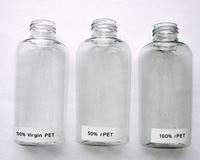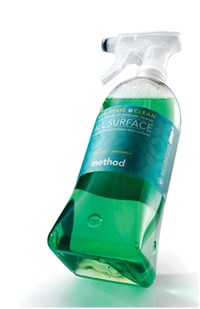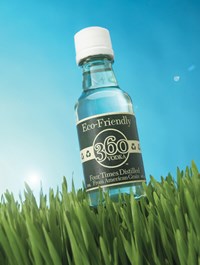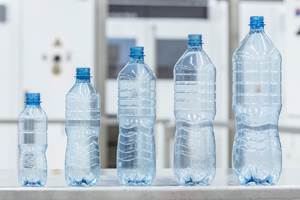Processing PCR: How It’s Done at a Leading PET Bottle Maker
Many food and beverage companies are either using or thinking about using recycled materials in their packaging.
Many food and beverage companies are either using or thinking about using recycled materials in their packaging. In addition to enhancing brand equity, using post-consumer recycled (PCR) plastics has a number of environmental benefits. Recycling reduces the amount of plastic sent to landfills, and using PCR helps support the recycling infrastructure. Using recycled PET means that less petroleum is needed to make new, virgin resin. Recycled PET also requires less energy to produce and has a lower carbon footprint than virgin PET.
There are several challenges to making bottles with recycled PET, and they increase with the percentage of PCR used. In general, there are no modifications required to machinery or molds, except for the additional equipment needed to store, handle, and blend PCR. However, using PCR often introduces subtle challenges and process considerations. Most often, the quality of the PCR resin will have the most impact on the challenges you’ll face in production.
WHY PCR IS CHALLENGING
For PET bottle processors, the source of almost all PCR is carbonated soft-drink, water, and other beverage bottles. In North America, most soft-drink bottles are collected by one of two methods. Some states have deposit or redemption systems to encourage consumers to recycle their bottles. These return systems usually result in the best quality recovered PET because the bottles are kept separate from other types of plastic and paper, glass, and other potential contaminants. Most bottles collected outside of the deposit or redemption systems are from curbside recycling programs. The PET bottles, and sometimes other containers made from PET, are often mixed with other types of plastic, metal, and glass containers that can contaminate the PET.
The PET resin used for carbonated soft drinks is not identical to the grades typically used for isotonic beverages and most water bottles. The most important difference is the intrinsic viscosity (IV) of the various resins. The IV of a resin increases with the length of its polymer chains, which have an effect on the strength and stretch characteristics of the PET bottle. The ratio of carbonated soft-drink to water bottles will have an impact on the resulting IV in the recycled PET.
In addition to IV, the two most critical quality variables when using PCR are color and contamination. Recycled PET tends to be darker and more yellow than virgin PET. Some of the color comes from reheating, but most comes from contaminants in the PET. Some of the contaminants that affect PCR color are oxygen scavengers, reheat enhancers, or other additives used in the original containers. Contaminants can also be microscopic pieces of foreign material such as other plastics, glass, sand, or metals. These small particles are bound in the plastic and don’t pose a hazard in food containers, but can sometimes be seen as black specs in the resin pellets or in the container. The color and amount of contamination in recycled PET depends on the source of the recycled bottles—deposit or curbside—and also the technology used to sort, wash, and grind the bottles.
PROCESSING PCR
For PET containers, PCR is used in varying amounts from less than 10% to 100%. At ratios below 25%, there are usually only slight differences when using PCR versus 100% virgin. At higher percentages, the use of PCR has a greater impact.
Using PCR requires some additional infrastructure compared with running 100% virgin PET. First, you need a place to hold the PCR. Smaller amounts can be handled in gaylord boxes or Super Sacks. Larger amounts of PCR usually warrant a separate resin silo to store the PCR, which can be delivered in bulk trucks or railcars. Blending equipment, such as a gravimetric blender, is required to mix the PCR with virgin resin at the desired ratio. It’s also possible to purchase PCR preblended with virgin resin, but this limits your options to one ratio. Preblending also increases your risk if the PCR turns out to have unacceptable levels of contamination.
Probably the most noticeable difference when using PCR instead of 100% virgin PET is the color. When attempting to make clear bottles from PCR, you will notice they will be somewhat darker and often yellower than those made of virgin PET. Because of variation in the sources of the PCR, it can be difficult to maintain a consistent color from batch to batch. Some food and beverage companies overcome these problems by adding colorant. A slight blue tint helps to mask the yellowness and create a more uniform color. Green, amber, or other colors also effectively mask the effects of high percentages of PCR, but they also mean the bottle can’t be recycled again into a clear bottle. If you do your own blending of PCR with virgin resin, you may be able to adjust the ratio of PCR to maintain acceptable color in the final container.
In addition to black specs, larger contaminant particles in PCR can cause problems in injection molding the preform. These contaminants are usually caused by some malfunction in the washing or melt-filtering process, such as a blown filter screen, and are not part of normal day-to-day operation. Otherwise, there is little difference in the injection molding process when producing a preform made of PCR.
Blow molding bottles with PCR usually requires a different set of process parameters than is typical for virgin PET. Because the PCR is darker, it more readily absorbs heat from the blow molding oven lamps, so lamp profiles often need to be adjusted. Small particles of contamination in PCR also can cause pinholes and leaks when blow molding the bottle. As the walls of the bottles are stretched during molding, particles of contamination can cause weaknesses that result in holes in the bottle wall. The number of defects will depend on the amount of contamination in the PCR resin and the design and wall thickness of the preform and final bottle.
YOUNG INFRASTRUCTURE
For packaging materials such as aluminum, glass, and paper, today’s economics and manufacturing processes often support the use of post-consumer recycled materials. With plastics, including PET, the demand for PCR is increasing, but the infrastructure to recycle and preprocess post-consumer plastics is not as well developed.
Using PCR to make new bottles starts with sourcing the right PCR for your application. At the converting plant there may be some infrastructure needed to store, handle, and blend the PCR resin. There generally won’t need to be modifications to the injection and blow molding equipment, but processes will probably need to be developed or at least fine-tuned. Using larger percentages of PCR may require colorants or ongoing management of the supply or of blend ratios to achieve consistent output.
About the Author
David Clark is director of sustainability for Amcor PET Packaging in Manchester, Mich. He joined Amcor in 1994 and has managed Amcor blow molding and recycling facilities and oversaw construction of a PET bottle plant. He can be reached at (734) 302-2801 or david.clark@amcorpet.com.
Related Content
Breaking News From NPE2024
Here is a firsthand report of news in injection molding, extrusion, blow molding and recycling not previously covered.
Read MoreFor Extrusion and Injection-Blow Molders, Numerous Upgrades in Machines and Services
Uniloy is revising its machinery lines across the board and strengthening after-sales services in tooling maintenance, spare parts and tech service.
Read MoreFirst Water Bottles With Ultrathin Glass Coating
Long used for sensitive juices and carbonated soft drinks, KHS Freshsafe PET Plasmax vapor-deposited glass coating is now providing freshness and flavor protection for PET mineral water bottles.
Read MoreRead Next
For PLASTICS' CEO Seaholm, NPE to Shine Light on Sustainability Successes
With advocacy, communication and sustainability as three main pillars, Seaholm leads a trade association to NPE that ‘is more active today than we have ever been.’
Read MoreLead the Conversation, Change the Conversation
Coverage of single-use plastics can be both misleading and demoralizing. Here are 10 tips for changing the perception of the plastics industry at your company and in your community.
Read More














